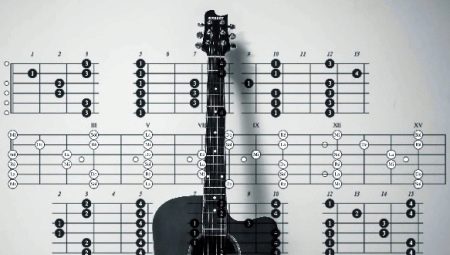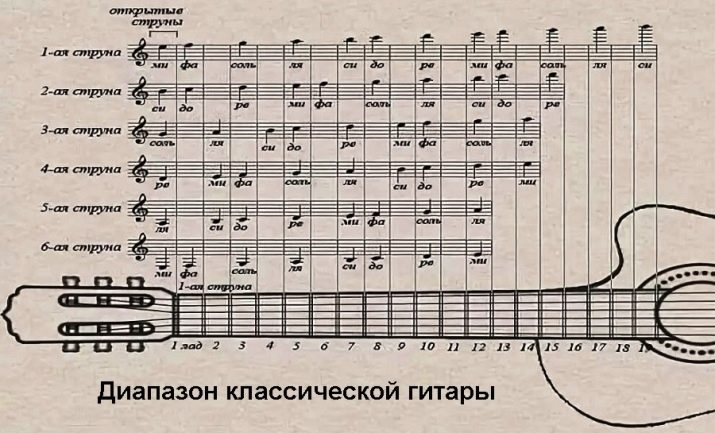Guitar octaves

A person who starts learning to play any instrument is primarily interested in knowing what its features and capabilities are. In this case, the most important are: tuning, sound range, timbre and level of complexity of playing technique. For many, the decisive factor when choosing is the range of a musical instrument, its ability to cover several octaves. This article will talk about octaves on the guitar: their number on the fretboard, location on the strings and frets.
What it is?
In music, the octave has several meanings.
- The interval between two notes that sound the same but differ in pitch (the frequency of the acoustic vibration of a lower sound is 2 times less than a high sound). If these notes are played simultaneously, then they merge into almost a single sound.
- Eight steps of any diatonic sound range, for example, from the note "E" to the next highest (down or up) note "E", from the sound "G" to the next "G" and so on.
- VIII stage diatonic scale.
- Tempered musical scale (scale), consisting of 12 semitones from the note "C" to the note "B". It is into such mathematically equal intervals (octaves) that the entire sound range of sounds used in music is divided.
According to the rule of the tempered scale, all sound musical material consists of 7 full octaves and 2 incomplete octaves. The lowest sounding is the subcontact. She is one of the incomplete octaves, in which there are only 3 sounds: "la", "B-flat" and "si". This is followed by full octaves: controctave, major octave, minor, first, second, third, fourth. The musical sound sequence is completed by the note "C" of the fifth octave.

All of the listed sound arsenal is contained in the piano keyboard. As for a six-string guitar with a classical tuning, it certainly cannot reproduce so many sounds.However, her own range is quite enough for her, which is discussed below.
How many octaves is there on a guitar?
The sound range of a 6-string, 19-fret, standard Spanish guitar starts with a minor octave E (open sixth string) and ends with a B of the third octave (19th fret of the first string). Thus, the sound range of a guitar contains 4 octaves:
- incomplete small;
- complete first;
- full second;
- full third.

The minor octave is represented by five notes (mi, fa, sol, la, si with the appropriate alteration). These sounds can be played either only on the 6th string, or the first 3 notes ("E", "F", "G") can be played on it, and the notes "A" and "B" - on the 5th.
The note "C" of the first octave is located on the guitar neck in two places - at the 3rd fret of the 5th string and the VIII fret of the 6th. It is not played anywhere else. The highest sound of the first octave "B" is found in several places on different strings: open 2nd string, 3rd fret 3rd, 9th fret 4th, XIIIth fret 5th and 19th fret 6th. On the neck of a guitar with 19th frets, 24 notes refer precisely to the first octave of the main scale. There is not a single sound of it only on the first string.
The second octave is more numerous for its pure (without alteration) sounds on the fretboard: there are 28 of them here. The "C" of the second octave can be played on four strings:
- on the 2nd (1st fret);
- on the 3rd (V fret);
- on the 4th (X fret);
- on the 5th (XV fret).
The octave-ending sound "B" will be produced on the first, second and third strings, clamped at the VII, XII and XVI frets, respectively. String number 6 does not contain sounds of the second octave.
The high sounds of the third octave are located only on the melodic strings (third, second and first). And even those are located above the VIII fret on the neck.

How to build and play?
The classical guitar tuning is thought out so subtly that you can build and play a scale of one octave from any sound in one position without moving along the neck. This is great for beginner guitarists. For playing a more complex melody (with a wider range of notes), you can also find the most rational place on the fretboard, given the location of the same sounds in different places and on different strings.
If it is necessary, for example, to play the first octave, then the easiest solution for beginners is to learn the scale in C major in the first position:
- "C" on the 3rd fret of the 5th string: hold with the # 3 (ring) finger of the left hand;
- "Re" - open fourth;
- "E" on the 2nd fret of the 4th string: hold down with the # 2 (middle) finger of the left hand;
- "Fa" on the 3rd fret of the fourth string: press down with the No.3 finger of the left hand;
- "Salt" - open third;
- "La" on the 2nd fret of the third string: press down with the # 2 finger of your left hand;
- "Si" - open second;
- "C" of the second octave (the scale should end with the sound "C" of the next octave) on the 1st fret of the second string: hold down with your left finger # 1 (forefinger).

It is more correct to play any scale in an upward movement and immediately in a downward movement.
In the case of two- and three-octave scales, it is better to use A. Segovia's fingering, developed by this outstanding musician for playing diatonic major and minor structures. Almost all guitarists began to develop their technical skills on this very material.
Consider a typical two-octave scale in C major with A. Segovia's fingering:

This scale allows you to play a variety of major structures from different sounds without changing the fingering. In other words, having learned just one scale from the "C" sound, you can play other major two-octave scales:
- from the note "re"by moving the entire fingering 2 frets higher along the fretboard (that is, starting it on the 5th fret from the same fifth string);
- from the note "mi", starting the order of fingers and strings from the 7th fret;
- from the note "fa"located at the VIII fret of the fifth string;
- from the note "si"located one fret below the C sound on the fifth string (fret II).
The highest sound in E major, starting from the E on the 7th fret of the fifth string, is produced at the 12th fret of the first string.
For a beginner studying a classical instrument, it is not worth moving his right hand beyond any finger of his left hand on the neck beyond the XII fret - it is not very convenient for an inexperienced guitarist to play there.
However, on an instrument that has a cutout on the body in the area of high thresholds, you can continue to shift your hand and play scales from the sounds "fa", "sol", "la" and even "si" of the first octave. It is good to play this typical scale, shifting in semitones., that is, playing also altered major constructions (C-sharp major, D-sharp major, and so on). One of the variants of the game is to move up the fretboard without stopping, playing successively all major keys that can be fingered (both up and down).
Typical G major scale in three octaves:

This major sequence starts from the second position, goes up to the twelfth and has three transitions in its movement:
- from the second (II) to the fifth (V);
- from the fifth (V) to the eighth (VIII);
- from the eighth (VIII) to the twelfth (XII).
When moving backward, there are only two transitions:
- from the twelfth position (XII) to the seventh (VII);
- from the seventh (VII) to the original second (II).
And if in the typical scale of C major the return back occurred unchanged along the same notes and strings, then in the G major in the downward movement a different path of strings and frets was chosen.
The G major construction, like C major, can also be played by shifting along the fretboard to other keys.
And in order to always be aware of which keys are being played at the moment, you need to know the tonal intervals between the sounds of the main scale:
- between the sound "C" and "D" 1 tone (2 frets on the guitar fretboard: for example, on the fifth string, "C" is at the III fret, and "D" is at the V);
- between "re" and "mi" - 1 tone;
- between "mi" and "fa" - 1/2 tone (adjacent frets);
- between "fa" and "salt" - 1 tone;
- between "salt" and "la" - 1 tone;
- between "la" and "si" - 1 tone;
- between "si" and "do" - 1/2 tone.

The indicated intervals should be preserved in the construction of the major scale from any sound.
When playing scales, it is more convenient for beginners to focus not on sounds, but on scale steps.
In C major, sounds are divided into the following steps:
- "Before" - level I (tonic);
- "Re" - stage II;
- "Mi" - stage III;
- "Fa" - stage IV;
- "Salt" - V step;
- "La" - stage VI;
- "Si" - stage VII;
- "Before" - VIII (I) stage.
Almost unmistakably, the major sequence of sounds can be maintained according to the formula: tone-tone-semitone-ton-tone-tone-semitone. Here, the order of the intervals in steps is reflected:
- between I and II steps - tone;
- between II and III - tone;
- between III and IV - semitone;
- between IV and V - tone;
- between V and VI - tone;
- between VI and VII - tone;
- between VII and VIII - semitone.
Among the minor ones, melodic scales are especially popular. A minor (typical and using an open 5th string) and E minor using an open 6th string. We present their fingerings in the figure below.

All scales are very useful exercises for mastering the guitar fretboard, as well as a technique for smooth transitions from position to position. In addition, they will help beginners quickly memorize the location of notes and octaves on the instrument's fretboard, stretch their fingers and increase their strength.








